Tahiti lies in the South Pacific. It is the largest of the 118 islands and atolls that comprise French Polynesia. Tahiti is in the Society Islands, an archipelago which includes the islands of Bora Bora, Raiatea, Taha'a, Huahine and Moorea, and has a population of 127,000 people, about 83% of whom are of Polynesian ancestry. The legendary name 'Tahiti' not only identifies this island but also the group of islands that make up French Polynesia.
Tahiti is composed of two volcanic mountain ranges. In the shape of a 'turtle', it is made of Tahiti Nui (the larger part) and Tahiti Iti (the peninsula). The two islands are linked by the isthmus of Taravao and skirted by black beaches.
- Pape'ete. is the capital, and the administrative centre. Once sleepy, today its harbour is busy with cargo freighters, copra ships, luxury liners and ocean-going yachts. There are cafes, shops overflowing with French fashions, shell jewellery and handicrafts and a wide variety of restaurants serving Tahitian, French, and Asian cuisine. Not an attractive city, there are many small shops selling black pearls, small goods, souvenirs. The marche draws many shoppers for local produce (including fish) or souvenirs. Popular cafe with Wi-Fi on second floor. Don't expect many stores to be open after 18:00. What is open are the food trucks by the harbour, some restaurants and bars, and lei vendors. Convenience stores a outside the city centre at service stations are open.
- Fa'a'ā. has the international airport built on the lagoon. Apart from the airlines check-in counters, there is an information counter, a snack bar, a restaurant and vehicle rental offices and shops. Nearby, in a special Tahitian-style house, artisans sell flower leis and shell necklaces. A fairly large, often grungy area. Home to a large mall, the Centre Commercial (i.e., the mall) south of the airport on the main highway and anchored by a Carrefour.
- Arue.
- Hitiaa O Te Ra.
- Mahina.
- Paea.
- Papara.
- Pirae.
- Punaauia.
- Taiarapu-Est.
- Taiarapu-Ouest.
- Teva I Uta.
Pape'ete. is the capital, and the administrative centre. Once sleepy, today its harbour is busy with cargo freighters, copra ships, luxury liners and ocean-going yachts. There are cafes, shops overflowing with French fashions, shell jewellery and handicrafts and a wide variety of restaurants serving Tahitian, French, and Asian cuisine. Not an attractive city, there are many small shops selling black pearls, small goods, souvenirs. The marche draws many shoppers for local produce (including fish) or souvenirs. Popular cafe with Wi-Fi on second floor. Don't expect many stores to be open after 18:00. What is open are the food trucks by the harbour, some restaurants and bars, and lei vendors. Convenience stores a outside the city centre at service stations are open.
Fa'a'ā. has the international airport built on the lagoon. Apart from the airlines check-in counters, there is an information counter, a snack bar, a restaurant and vehicle rental offices and shops. Nearby, in a special Tahitian-style house, artisans sell flower leis and shell necklaces. A fairly large, often grungy area. Home to a large mall, the Centre Commercial (i.e., the mall) south of the airport on the main highway and anchored by a Carrefour.
Arue.
Hitiaa O Te Ra.
Mahina.
Paea.
Papara.
Pirae.
Punaauia.
Taiarapu-Est.
Taiarapu-Ouest.
Teva I Uta.
Tahiti and her islands are some of the most beautiful in all the South Pacific. Tahitians are very respectful, generous and kind. To hear random people say 'hello' on the street to strangers or even passersby is not uncommon. Many of the Tahitian kids are well into rap and hiphop, performing or practicing in the streets or in public squares.
The philosophy of the people, 'aita pea pea' (not to worry), truly is the Tahitian way of life. Be patient and polite to them and you will get anything you ask for, including a large smile. They are very warm and welcoming people.
Your trip to Tahiti may be a one-time but unique experience due to its high price. Though not legally binding, more and more couples are renewing their marriage vows and will be bedecked in pareus, flowers, shells and feathers. The groom approaches the beach in an outrigger canoe. His bride, carried on a rattan throne, awaits him on the white-sand beach. A spectacular sunset, Tahitian music and dancers add to the ambiance. A Tahitian priest "marries" the couple and gives them their Tahitian name and the Tahitian name of their first-born.
The generally accepted theory states that Polynesians first settled in the Pacific around 4,000 years ago. Using wooden double-hulled sailing canoes lashed together with natural fibers and applying their knowledge of the wind, currents and stars, the first intrepid navigators sailed eastward, settling the central island groups of the Cook Islands and French Polynesia between 500 BC and 500 AD.
Other great expeditions undertaken around 1000 AD established the Polynesian triangle consisting of Hawaii (to the north), Easter Island (to the east), Tahiti and her islands (to the west) and New Zealand (to the south-west.) The various languages derived from the ma'ohi that are spoken in these islands testify to the common origin of their peoples.
In the 16th century, Magellan reached the Tuamotu Islands and the Marquesas. However, the name of Englishman Samuel Wallis is the one most often associated with the European discovery of Tahiti in 1767. The following year, the French navigator Antoine de Bougainville named it 'New Cythera'. A year later, it was the English Captain James Cook's turn to land and take possession of the Society Islands.
At that time, Tahiti and her islands were divided into several chiefdoms and kingdoms. Around 1797, one of the chiefs succeeded in affirming his supremacy and established the 'Pomare dynasty' with the help of the Europeans. During the First and Second World Wars, many islanders left to fight alongside French troops. In 1958, the EFO (French Establishments of Oceania) became French Polynesia. The 1960s marked a turning point when the establishment of CEP (Center for Experimentation in the Pacific) in 1963 rapidly propelled them into the modern age. This was characterized by the influx of people from outlying islands to Tahiti, the growth of local businesses and an increase in the standard of living.
The weather is ideal! The climate is tropical. The average ambient temperature is 80°F (27°C) and the waters of the lagoons average 79°F (26°C) in the winter and 84°F (29°C) in the summer. But do not worry, most resorts and hotel rooms are air conditioned or cooled by ceiling fans.
Summer with a warmer and more humid climate is from November through April, and winter is from May to October, when the climate is slightly cooler and drier. When you step out of the airplane, you'll immediately notice that the air is warm and humid. Consequently, besides your camera and your extra memory cards, do not forget to pack lightweight cotton clothes, sunscreen lotion and a baseball cap or a wide brimmed hat. Synthetic fabrics can get hot and sticky in the tropics.
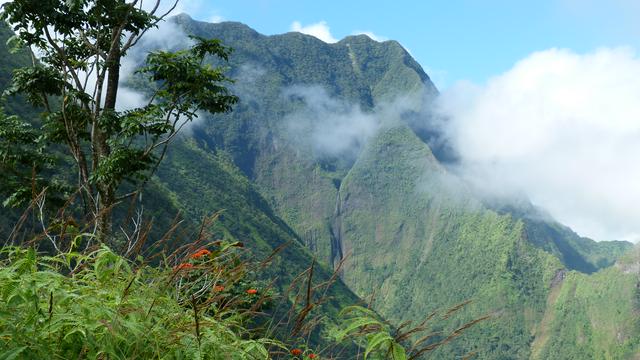 French and Tahitian are the most spoken languages, but English is widely understood in the tourist areas, but not in less frequently visited areas (such as the remote islands of the Tuamotus). Most signs are in French, very few of them in Tahitian.
French and Tahitian are the most spoken languages, but English is widely understood in the tourist areas, but not in less frequently visited areas (such as the remote islands of the Tuamotus). Most signs are in French, very few of them in Tahitian.
Brush up on your Tahitian and French:
Tahitian:
- Iaorana (E-yo-or-ahna) = Hello
- Mauruuru (ma-rou-rou) = Thank you
- Vahine (vah-heen-ney) = Woman
- Tane (tah-ney) = Man
- Nana (nah-nah) = Goodbye
- Maeva (ma-ay-va) = Welcome
- Fare (fa-ray) = House/bungalow
French:
- Salut/Bonjour (sal-oo)- (bon-jour) = Hi/Hello
- A bientot (ah-bee-yen-toe) = See you soon
- Femme/Fille (fam/fee) = Woman/Girl
- Homme/Garçon (ohm/gare-sohn) = Man/Boy Many Tahitians end up mixing up words in French and Tahitian. An example would be a Tahitian asking where his "vini" is instead of using the French word for cellphone. "Où est mon vini?" "Where is my cellphone?" This is very common.
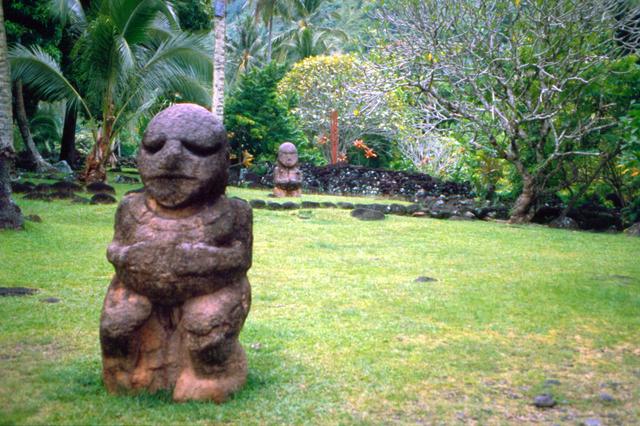
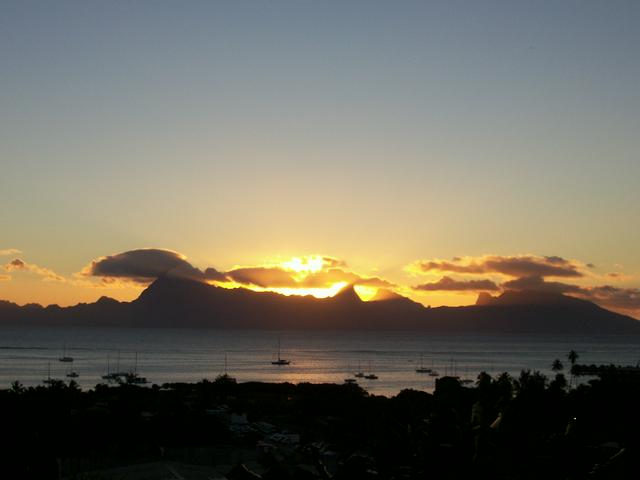 There are many things to do in Tahiti and a lot to see and take pictures of. Should you embark on a circle island trip (of around 70 miles/112 km), some of the must see things would include:
There are many things to do in Tahiti and a lot to see and take pictures of. Should you embark on a circle island trip (of around 70 miles/112 km), some of the must see things would include:
- 'Le Marché'. This is the large two-story Papeete's market place where many things can be bought. Buy your lunch here and some "Monoi". "Monoi" is the local tahitian oil, strongly scented and worth a good price. It is used to get tanned and moisturize your skin. Also buy a "pareu". This is typical tahitian clothing that can be tied into many different ways (a cover-up, a dress, shorts, a shawl). It can also be spread out as a picnic cloth or a beach towel. Created with traditional designs and bright tropical colors, they are inexpensive and make the perfect souvenir. This is especially good for getting to know Tahitians as every Tahitian knows how to tie one. Le Marche is also the place where you'll find jewellery as well as many calendars, postcards, cups... Ripe fruits, scented soaps, vanilla beans, dance costumes, wooven hats and bags and shell necklaces up to your ears are what you'll find in the market. It is centrally located and you can't miss it.
- The Arahoho blowhole on the North side of Tahiti Nui. An area where a blowhole in the shore has formed on the road and whose waves crash inside the rock cliff.
- Les Trois Cascades. Three beautiful waterfalls inside the island of Tahiti Nui. The path had been closed by a rockfall; check with the tourist office on updates or chance going if you are close by. The pedestrian bridge is chained shut.
- Tomb of King Pomare the Fifth. The tomb of the only king of Tahiti, when it was a monarchy.
- Pointe Venus Lighthouse. Black sand beach and clear blue water by a fishing reef. Popular with young Tahitians.
- Botanical Garden/Gauguin Museum. At Papeari, on the west coast, the botanical garden made by Harrison Smith lies alongside the Gauguin Museum in the magical setting of the Motu Ovini.
- The Olivier-Breaud Golf Course. You can admire the wonderful layout of this golf course set in the magnificent Atimoana complex which was a sugar cane farmland rum in the 19th century.
- Arahurahu Marae. A restored religious site containing various stone block structures dedicated to the old gods and where important ceremonies used to take place.
- Museums. It is interesting to visit the Museum of Tahiti and the Islands which has a rich collection of very old pieces and reconstructed historical scenes. The Black pearl museum as well as the Gauguin museum are fun to see if you want to get out of the heat.
- To'ata. A square with small restaurants (see "Eat") but also the place to be for the July celebrations with dance and traditional music, the Heiva I Tahiti.
'Le Marché'. This is the large two-story Papeete's market place where many things can be bought. Buy your lunch here and some "Monoi". "Monoi" is the local tahitian oil, strongly scented and worth a good price. It is used to get tanned and moisturize your skin. Also buy a "pareu". This is typical tahitian clothing that can be tied into many different ways (a cover-up, a dress, shorts, a shawl). It can also be spread out as a picnic cloth or a beach towel. Created with traditional designs and bright tropical colors, they are inexpensive and make the perfect souvenir. This is especially good for getting to know Tahitians as every Tahitian knows how to tie one. Le Marche is also the place where you'll find jewellery as well as many calendars, postcards, cups... Ripe fruits, scented soaps, vanilla beans, dance costumes, wooven hats and bags and shell necklaces up to your ears are what you'll find in the market. It is centrally located and you can't miss it.
The Arahoho blowhole on the North side of Tahiti Nui. An area where a blowhole in the shore has formed on the road and whose waves crash inside the rock cliff.
Les Trois Cascades. Three beautiful waterfalls inside the island of Tahiti Nui. The path had been closed by a rockfall; check with the tourist office on updates or chance going if you are close by. The pedestrian bridge is chained shut.
Tomb of King Pomare the Fifth. The tomb of the only king of Tahiti, when it was a monarchy.
Pointe Venus Lighthouse. Black sand beach and clear blue water by a fishing reef. Popular with young Tahitians.
Botanical Garden/Gauguin Museum. At Papeari, on the west coast, the botanical garden made by Harrison Smith lies alongside the Gauguin Museum in the magical setting of the Motu Ovini.
The Olivier-Breaud Golf Course. You can admire the wonderful layout of this golf course set in the magnificent Atimoana complex which was a sugar cane farmland rum in the 19th century.
Arahurahu Marae. A restored religious site containing various stone block structures dedicated to the old gods and where important ceremonies used to take place.
Museums. It is interesting to visit the Museum of Tahiti and the Islands which has a rich collection of very old pieces and reconstructed historical scenes. The Black pearl museum as well as the Gauguin museum are fun to see if you want to get out of the heat.
To'ata. A square with small restaurants (see "Eat") but also the place to be for the July celebrations with dance and traditional music, the Heiva I Tahiti.
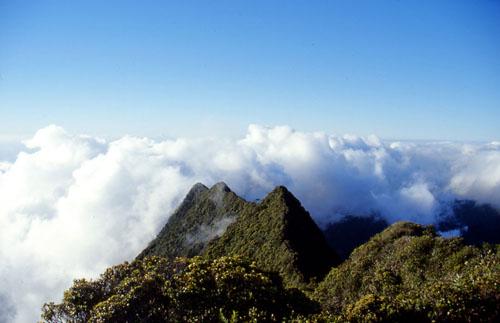
- All nautical activities: surfing, scuba diving, snorkeling (most resorts will provide you with the equipment for free), canyoning, stingray and shark feedings, water sports, deep sea fishing, kitesurfing. Use reputable dive company for diving, those with the far out websites are reportedly a bit low on ethics and safety, not well prepared and do not go far past the marina.
- On land you also have the possibility of for example hiking, 4WD safari and golf.
- Deep sea fishing has been curtailed on Tahiti and is difficult to find.
All nautical activities: surfing, scuba diving, snorkeling (most resorts will provide you with the equipment for free), canyoning, stingray and shark feedings, water sports, deep sea fishing, kitesurfing. Use reputable dive company for diving, those with the far out websites are reportedly a bit low on ethics and safety, not well prepared and do not go far past the marina.
There are many of the shops around the centre near "Notre Dame".
If you are dreaming of a tattoo, those available in Tahiti have unique patterns which are said to reflect the spirit of the island. There are lots of places to get tattooed around Papeete including the market. You may also want to buy a black pearl, and available a good prices in the market.
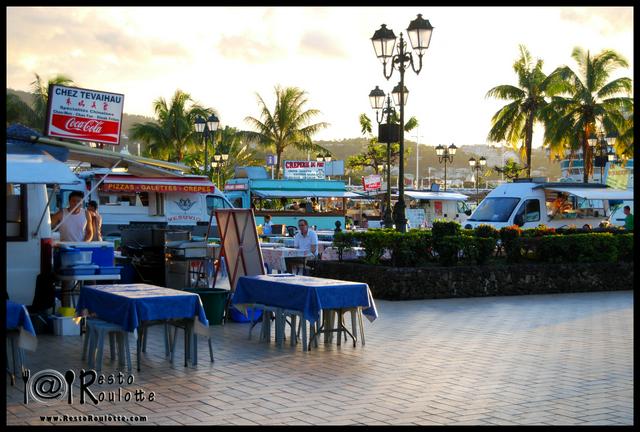 Tipping is not a custom in Tahiti. It is beginning to be seen in some of the restaurants and hotels on the larger islands, but in general Tahitians do not expect your tip.
Tipping is not a custom in Tahiti. It is beginning to be seen in some of the restaurants and hotels on the larger islands, but in general Tahitians do not expect your tip.
"Roulottes" (snack shops on wheels) are especially popular on Friday nights to get some great Chinese food, crepes, and French-style dishes. You won't miss it since it is located along Papeete's waterfront. Unbelievably delicious meals at bargain prices in a fun and local atmosphere. When possible eat here as a meal for two can cost 1000-1500 F (Feb 2019), which is much less than a hotel meal (plus you get plenty of food).
The main island dish to try is the "poisson cru" ("raw fish" in French.) It is a fresh fish marinated with lime juice and coconut mixed with vegetables. Many varieties can be found all over including Poisson Cru Chinois (Chinese style), Poisson Cru Ananas (pineapple style). Parrotfish, ahi, mahi mahi, and other fresh fish are divine in a light sauce made from Tahitian vanilla and coconut milk. Do not miss the exotic tropical fruits.
Baguettes are found all over the island at a very reasonable price. As well as baguettes, Tahitians have created the "baguette sandwich" where everything from fish to french fries are stuffed into.
Make sure you also try the very popular Chinese ma'a tinito (which is a mixture of pork, kidney beans, Chinese cabbage and macaroni.)
Family occasions and celebrations are the time for a huge tamara'a Tahiti (Tahitian-style feasts) where a meal consisting of suckling pig, fish, breadfruit, yams and fe'i bananas is wrapped in banana leaves and steamed in an earth-dug oven over layers of hot rocks.
If you are looking for fine dining try Paea south of Papeete to Chez Remy or Le Carre at Le Meridien. Pricey, but fantastic meals, large French menu and best wine and drinks selection, and very friendly, relaxed staff who also spoke perfect English. The papaya dessert is delicious. US$28–45 per person. The Italian restaurant near the Le Meridien entrance is also good, especially stone oven baked pizza and the Anchovie-Caper-Olive Spaghetti.
Tips: get French creamed cheese at breakfast on your crepes.
Also, plan for your meals. Many restaurants don't open until 19:00. Some of the hotels have multiple restaurants that serve different menus at different times of the day, and changes by day, which made for limited selections and inability to order something you saw the day before. Some restaurants and businesses on the island close from 12:00-13:00, some until 15:00, which can make shopping and eating on a whim difficult. (Can't blame them, it's hottest then.)
Bottles of water are readily available. Being a French territory, wine is common and easy to find. As this is a tropical island, a multitude of fruit juices from pineapple juice to coconut milk are to be found everywhere. It is sometimes better to crack open your own coconut yourself and drain it for lunch. If you're a fan of beer, the Hinano Beer will be one to taste, and perhaps bring a few cans home.
Music and dancing tell the story of the Tahitian people. Most hotels feature evening entertainment. Club dancing is also available in downtown Papeete but close at 03:00. You will probably not even get out that late, so tired that you will be from spending so much time in the sun discovering the island.
Many resorts have business centres from where you can have high-speed Internet access.
Papeete's Central Post Office is open weekdays from 07:30 to 11:30 and from 13:00 to 17:00 or 18:00. Saturdays from 07:30 to 11:30.
Tahiti has one of the lowest crime rates within France and its territories. However, petty crime, such as pickpocketing and purse snatching occurs.
Medical treatment is generally good. Two major hospitals as well as several private clinics provide 24-hour medical service.
As an overseas territory of France, defence and law enforcement are provided by the French Forces (Army, Navy, Air Force) and Gendarmerie.
Be sure to bring jelly-type sandals for walking amidst coral in the water and along the beaches or either old sneakers so you don't cut your feet on the coral or don't step on a stonefish.
Encounters with sharks in the lagoon will be most likely when scuba diving or even snorkeling but they are totally inoffensive. So are stingrays. However, be aware of moray eels which hide deep in the corals and whose bite can cause serious injury.
No vaccines are required.
People often know about Tahiti and Bora Bora but the following are other wonderful islands that should absolutely be visited:
- Moorea
- Maupiti
- Tetiaroa
- Huahine
- Raiatea
- Taha'a
- Fakarava
- Nuku Hiva
- Rangiroa
- Manihi
- Tikehau
- You can also take a direct flight to spectacular Easter Island - Tahiti is the only place in the world apart from Santiago de Chile where you can do this.
[[Moorea]]
[[Maupiti]]
[[Tetiaroa]]
[[Huahine]]
[[Raiatea]]
[[Taha'a]]
[[Fakarava]]
[[Nuku Hiva]]
[[Rangiroa]]
[[Manihi]]
[[Tikehau]]
